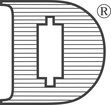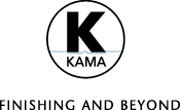Hot foil stamping
also foil hot stamping
The hot stamping foil is a process in which under the action of transfer of pressure, temperature and contact time layers of an embossing foil, using a die on the material to be refined. This differs from the blind embossing, with the addition of material deformation no material transfer takes place.
Technical Background
As embossing tools are either embossing dies or embossing rollers used, which are present as high-pressure form. Two embossing tools have in common that the key elements are raised and that they are heated before the operation. The temperature is strongly dependent on the used stamping foil, the printing and the machine type. In the graphic arts industry, a temperature of 80 ° C and 220 ° C are used.
The raised areas of the embossing tool occur during the embossing process with an embossing foil in contact, which consists of several layers. A carrier film serving as a base layer, a separation layer is applied, which melts by the use of the heated embossing tool and works so releases the transfer layers lying above it. The transfer layers include the optically active layers, and the adhesive layer. The adhesive layer(a reactivatable adhesive) connects the optically effective layer durable and smudge with the substrate. Color pigments, metallic pigments and paints can be used, resulting in very different visual effects results for the optically active layer.
Find a combination of hot foil stamping instead, this can be done in a single stage or two-stage system. The one-step method relief and foil are transferred in a single operation, thereby register differences between the transferred film and the deformation can be prevented. The two-stage process which occurs with steep gradients used particularly for high reliefs effected the formation of the relief and the transfer film in two operations. First, the film is transferred onto the stamp material and the next step is the creation of a relief by a blind embossing. Here the addition operation to be executed not only requires high precision in order to avoid misregistration, but also increases the cost.
The hot foil stamping can be done with the following embossing systems: flat against flat, which finds application in the processing of book covers; round against flat, which is executed at fine cardboards; and round to round, which finds its use in labels. Due to the different design options as plan embossing, relief stamping or embossing, the embossed structure material becomes even more individuality.
Effect
This embossing variant acts through visual and tactile effects. Frequently metallized films are used to achieve high quality in particular with gold or silver colored effects. In addition, a high contrast between matt and glossy elements. Also targeted haptic effects between embossed and non-embossed surfaces are accessible. The design are no limits, you can characterize both refined and subtle elements.
Application Possibilities
The hot stamping foil is mainly used in the refining of book covers, envelopes, brochures or for quality magazines, as well as certificates, vouchers, entry and business cards. Other eligible products are covers for brochures and business stationery.
Limitations
Boundaries for the hot embossing foil are determined by the surface structure, surface adhesion properties (printability), and the elastic behavior of the material. Moreover, the material used must have a minimum level of heat resistance, so that a transmission by means of the heated embossing tool can be done.
Je rauher und grobstrukturierter das zu veredelnde Material ist, desto flächiger und größer müssen auch die Motivelemente sein.
Costs
When hot foil embossing, the fixed costs are charged by the die, which must be specially made for each subject. The additional cost depends on the size of the motive and the areal utilization of stamping foils. The lower the circulation, the greater the impact on the total cost. Two-stage methods are also costly due to the additional workload.
Sources and additional literature
[1]
Arbeitskreis Prägefoliendruck; Böcher, Hans-Georg (Hrsg.): Prägefoliendruck,
Verfahren, Technik und Gestaltung, Heidelberg: Hüthing GmbH & Co. KG, 2005
[2] Liebau,
Dieter; Heinze, Inés: Industrielle Buchbinderei. 3. Auflage. Itzehoe: Verlag
Beruf + Schule, 2010
[3] Beckmann,
Till; Morlok, Franziska: Extra: Enzyklopädie der experimentellen
Druckveredelung; Birkhäuser Verlag, 2009
[4] Webseite Arbeitskreis Prägefoliendruck
[5] Webseite Achilles
[6] Webseite KAMA
[7] Webseite Gräfe
[8] Webseite Bölling
https://boelling.com/portfolio-item/heissfolienpraegung/GmbH & Co KG


